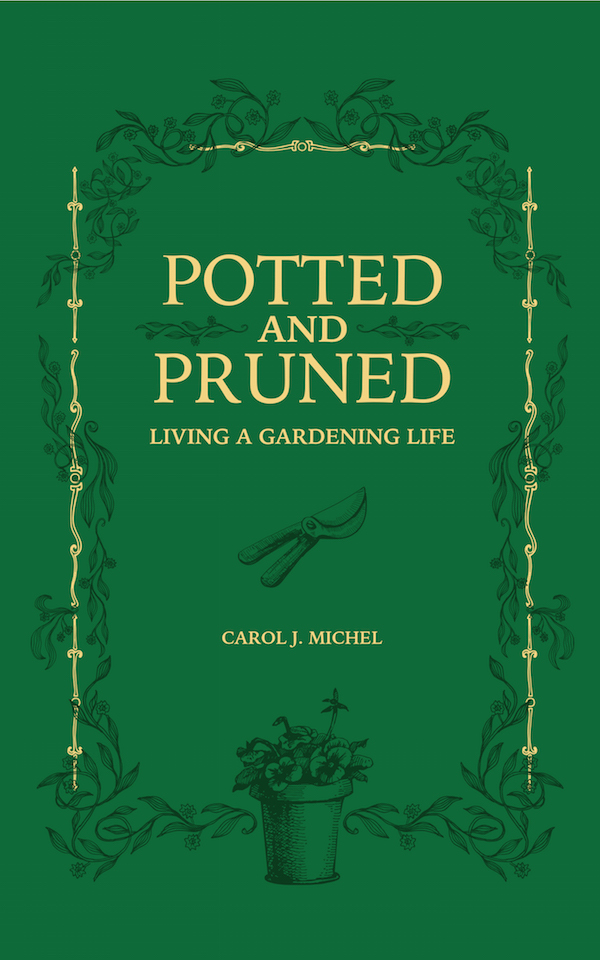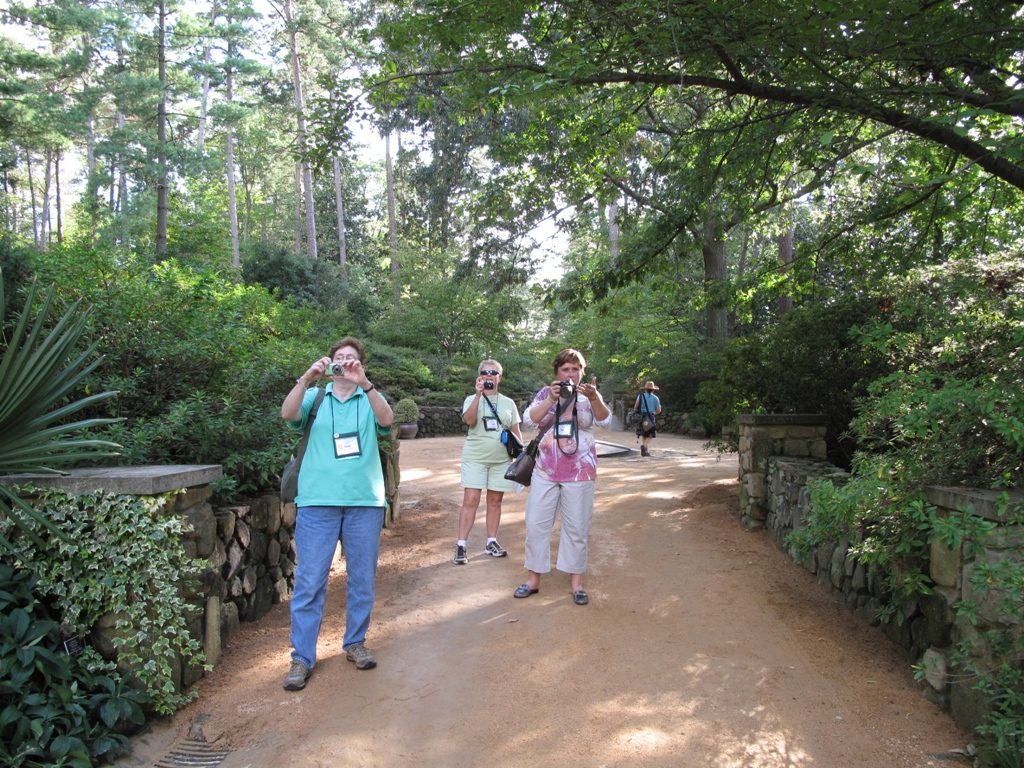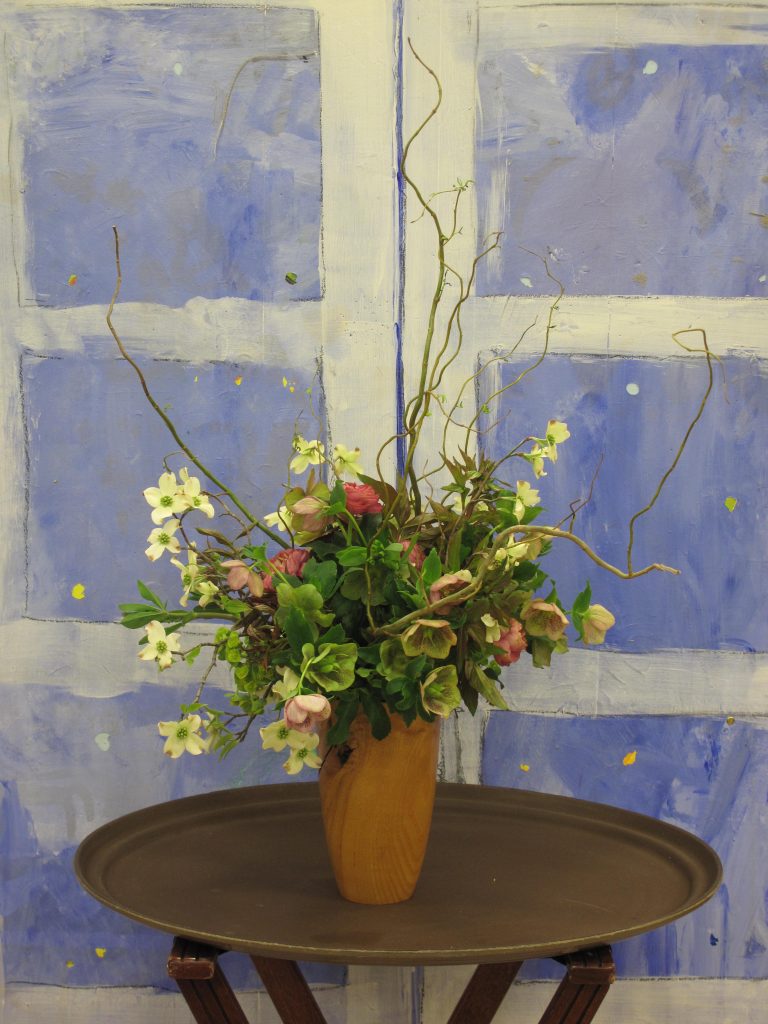
Carol Michel, author of the award-winning blog May Dreams Gardens, has penned a delightful book of 36 gardening stories that treat readers to a glimpse behind the garden gate.
In Potted and Pruned: Living a Gardening Life, Carol recounts her years spent speed weeding, scolding plants for their poor manners, experiencing the magic of a clover lawn, searching for elusive “rare in cultivation” plants, narrowly avoiding tussles in the garden center, formally evicting drought from her garden, and offering advice for those new to gardening.
Author Mary-Kate Mackey says, “Comics categorize types of laughter, including the laugh of recognition. That’s what Potted and Pruned evokes—all gardeners can see themselves and their foibles in this series of charming essays. Ms. Michel also manages to slyly insert great gardening advice among her observations. An enjoyable must-read for garden lovers everywhere.”


Carol and I are longtime gardening friends, but I followed her blog well before we actual met through mutual blogger pals in 2009 at the annual GWA: The Association for Garden Communicators symposium held in Raleigh, N.C.
She delivers her punch lines in a downbeat, low-key way. Usually the a-ha moment occurs a little while after Carol has spoken some bon mot that ultimately cracks me up. If you have any doubt about her wry take on gardening, well, check out her entire and extensive hoe collection, photos of which are posted on her web site.
Plus, chuckle at the names of her cast of characters at May Dreams Gardens. Carol cleverly names these *possibly imaginary* folks with as much aplomb as Click and Clack of Car Talk named all their producers and mechanics. (A favorite of mine: Gloriosa Vanderhort, Carol’s stylist who is helping her expand the palette of green she uses to decorate her life.)
I am so excited to share Carol’s story with you. If it’s true that everyone has a book in them, then she effortlessly demonstrates how to turn that inner dialogue of yours into a book that’s highly personal and utterly readable. Enjoy our Q&A:
 SFJ: How long have you been writing about gardening?
SFJ: How long have you been writing about gardening?
CM: I started regularly blogging about gardening in 2006. My first article for which I was paid was published in summer 2009. Oddly enough, in my high school yearbook they predicted that someday I’d be writing plant descriptions for Burpee. I’m not doing that yet, but who knows what the future holds.
SFJ: Who/what influenced you to start writing a garden blog?
CM: I always wanted to write about gardening but didn’t know how to get published in any magazines. I never even thought about a book. Then I heard about blogging and decided I’d start a blog and see where it went. I officially started the blog in 2004 but posted only a few times until 2006 when someone left me a comment. Having that quasi-dialogue with other gardeners really got me excited to write more.
SFJ: Your blog, May Dreams Gardens, was one of the first that I discovered back in 2006 or 2007 — when did you actually start it?
CM: Officially 2004 but I always consider 2006 as the year I really got into blogging.
SFJ: To what do you attribute the popularity of May Dreams Gardens?
CM: I came up with a meme called Garden Bloggers’ Bloom Day. Inspired by a quote by the southern garden writer, Elizabeth Lawrence (“We can have flowers nearly every month of the year”), I put out the word in 2007 for other garden bloggers to post on their blogs about what was blooming on the 15th of each month and then leave a link on my blog so we could find them. I can’t believe I’m still posting faithfully about bloom day on the 15th of every month 10 years later, and so are many other garden bloggers. I think that helped people find my blog and then I hope the interesting posts kept them coming back.
Author’s Note: I believe I participated in Garden Bloggers’ Bloom Day only a few times. This was my first time to post and Carol commented immediately. December 15, 2008!
SFJ: You have an unconventional perspective but I can tell you are 100% in love with gardening and plants. Describe your relationship with your own garden.
CM: That’s a tough question! My gardening is my outlet for fun and creativity. It wears me out some days but always has something to offer in return for my time and attention—a new bloom, a ripe tomato, an interesting insect or bird. Everyday it seems I learn something new about gardening. Though I’ve been gardening since I was a toddler, I tell people that plants and horticulture are such a broad areas of knowledge, I can learn something even from someone who just started to garden “yesterday”.
SFJ: What was the impetus to write this book, Potted and Pruned?
CM: After 10-plus years of blogging, I felt like I had some good essays about gardening that were trapped in the online world. By putting some of the essays in a book, (potting them up and pruning them first) I hope to reach a new audience of gardeners who haven’t discovered garden blogs. Plus I read once that the Smithsonian Museum and other archivists would far rather preserve something on paper than in an electronic format. Though I don’t think my book is by any means worthy of a museum, I hope that someday a gardener discovers it in a used bookstore, the way I’ve discovered old gardening books in used bookstores.
SFJ: You seem to be everywhere sharing that gorgeous green cover and your humorous way of inserting the book into uncommon settings. Are you having fun being a self-published author?
CM: I am having fun! I knew my book wasn’t the typical “how to” gardening book and I didn’t want a publisher to try to make it something other than what I had in mind, so I became my own publisher, with a lot of help from a managing editor, a copy editor, a content editor and a graphic designer. I’m pleased with the response to it so far and have already started on a second book.
SFJ: Can we share a passage or two? I would love to share excerpts from your favorite essay!
CM: My favorite essay? That’s kind of like picking your favorite plant in your garden! I’m particularly fond of the essays written as letters, especially the letter to my favorite old, now retired, gardening t-shirt. Someone else told me that Chapter 6 alone was worth the price of the book and someone else told me the chapter on GADS [Garden Attention Distraction Syndrome] was exactly how they garden.
A Letter to My Favorite T-Shirt
My dearest, oldest favorite gardening T-shirt,
I knew this day was coming. I could sense it when we last gardened together yesterday. This day when we would finally have to say goodbye to one another.
We had some good times in the garden, didn’t we?
Remember all the times we planted the vegetable garden in May? You were as delighted as I was to feel the sun on your soft green fabric after months inside a dark drawer. I’ll always appreciate, too, how willing you were to mow the lawn with me even though I’d sweat and get you all wet. You never complained. You were one of the best at keeping me cool.
I see now how all our time together in the garden has taken its toll on you, especially around your frayed and worn collar. Those holes on the shoulder seams, too. Oh gosh, do you remember how you’d make those holes on your shoulders look like bugs and then I’d swat at them? I’d laugh and you’d, well, you did what T-shirts do when they play tricks on their wearer.
I’ve also noticed some stains on you that just won’t go away. I think these stains came from that time you helped me unload mulch from the bed of the pickup truck. It seems one corner of the truck’s tailgate always had some grease on it that would get all over you.
I don’t mind wearing you with some stains, not after all the seasons we’ve been through together in the garden. But lately, some holes have shown up in places where a lady might not want to have a hole in her T-shirt.
I know you are just worn out. I understand, truly. We had a good run, though, didn’t we? How long has it been since you were crisp and new with a little price tag hanging from your collar? I’m guessing maybe 15 years? That’s a long time for a T-shirt. You should be proud. I’m proud of you! You were my delight and always one of my all-time favorites.
Even though we won’t be gardening together again, I’ll never forget you. I’m going to keep you around. You deserve that. You don’t deserve the rag drawer or, worse, the trash. No, you deserve to be kept all clean and nicely folded, in a place where we can meet every so often just to reminisce about how much less a bag of top soil seemed to weigh when we first gardened together.
As long as I’m around, you’ll be around too. I promise.
Thank you, dearest T-shirt of mine, from the bottom of my gardening shoes to the tip of my trowel for being so wonderful to wear for all these years.
With a shared love of gardening,
Carol
SFJ: I don’t have a favorite because each of these essays is a gem, but can we share a bit from A “Gardener’s Guide to Temporary Botanical Names”?
CM: You may share whatever you’d like to share.
A Gardener’s Guide to Temporary Botanical Names
A friend of mine, who knows not a whit about gardening, likes to test my knowledge of plants by pointing at a tree or shrub or flower and asking, “What’s that?” Then I fire back with the botanical and common name of the plant. She responds that I could be making up the name and she would never know.
She’s right. I could be making up the name and she and many others would be none the wiser. In fact, I actually find it useful to know a few temporary botanical names to use in those situations where I don’t know the actual botanical name of the plant.
Using temporary names sounds better than, “blah, blah, blah,” smarter than, “uh, uh, uh” (if you feel the need to sound smart), and serves as a placeholder of sorts until you have a chance either to remember the real botanical name or look it up. No harm done, unless of course my friend actually remembers my temporary name and uses it to sound smart in front of others.
Regardless, I have a fallback list of temporary names.
Forgetia, pronounced “for-get-ee-ya.” I use this genus name along with an appropriate descriptive species name when I have honestly forgotten the botanical name. Later I will spend some time searching online or looking in reference books to jog my memory.
For example, Forgetia rosea might be a plant with a pink flower. Or Forgetia giantosa might be the biggest plant in your garden, the one you can’t believe you can’t remember the botanical name for.
Lookupsia, pronounced “look-up-sia.” I find this to be a useful temporary genus name when I know I’ve recorded the name of the plant in my garden journal, and I just need a minute to go in and look it up. Again, you can combine it with any descriptive species name so it sounds more complete.
For example, Lookupsia orchida is a good temporary name for the hardy orchid I planted years ago, the one I can never remember the name of when it first pops up in spring until I look it up in my garden journal. Then I can remember it for the rest of the season until the long winter wipes it from my memory again.
Neverknewia, pronounced “nev-er-new-ia.” I think this name is most useful when you are visiting a garden and you really have no idea what the plants are. Perhaps it is a garden in a different climate from your own, where many of the plants may be new to you. You are one lucky gardener to be visiting gardens in other climates.
Eventually, some other person will come along and ask you what is. You can answer “Neverknewia plantsia” in a soft little voice, and then they may politely correct you saying, “Really, it looks more like a rose to me.” At that moment you can drop the temporary botanical name and loudly call it by its real botanical name, Rosa (or whatever it turns out to be).
Weedisia, pronounced “wee-de-sia.” I use this genus name when someone asks me the name of a plant I am pretty sure is a weed I should have pulled. Then, when the other person isn’t looking or has left the garden, if it is my garden, I pull that darn weed. And absolutely, even if they beg, do not dig and divide it and give it to them as a passalong plant.
For example, Weedisia prolifica would probably work for most weeds because most weeds are usually prolific.
Now if you think all these temporary botanical names are just foolishness and want to know how to avoid being in situations where you feel you need to use one of them, I have one suggestion—visit gardens by yourself. But what’s the fun of that? There is no shame in not knowing the names of every plant you see, even if you are the world’s best gardener or a trained horticulturist. No one can know every plant in the plant kingdom by its botanical name.
So for those times when you don’t know the name of a plant, give it a temporary name, at least until you have a chance to figure out what it really is.

SFJ: Anything else you wish to add that I have failed to ask?
CM: I love “living a gardening life” and want others to love gardening, too. That’s why I call myself a “gardenangelist”, an evangelist for gardening. Within five minutes of talking to someone, I’ve usually brought up the subject of gardening. I cannot imagine my life without gardening.
SFJ: How can people order a signed copy of your book? Or the book on its own, but who would want an unsigned copy!?
CM: I have an online store and your readers can order directly from me there.
Find Carol on Instagram @IndyGardener

 A Letter to My Favorite T-Shirt
A Letter to My Favorite T-Shirt